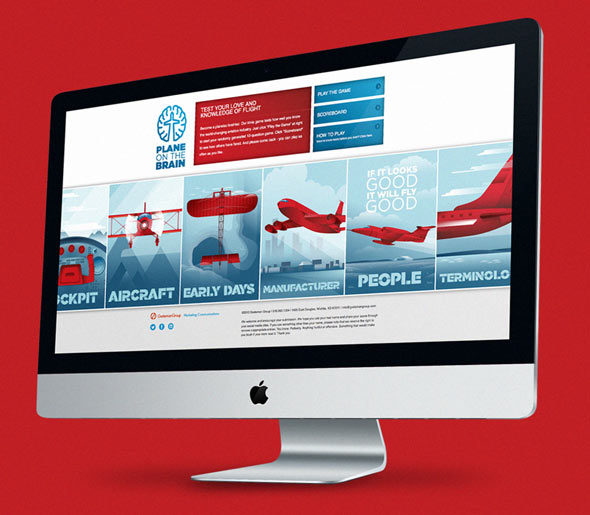Clean-Sheet Design Your Aviation Marketing with a Game
01.25.14 · Greteman Group
A blank page can be your springboard to inspiration. Recently, when faced with the challenge of creating a campaign for our own agency, we didn’t know exactly where we wanted to take it, only that it should be someplace new. And great. I’m happy to report, this creative challenge resulted in our best results ever. We created a buzz, drove our social likes, exponentially multiplied our web visits, more than doubled our typical email opens – and even generated some new business inquiries. We learned a few things along the way that could benefit you, too.
Develop Something of Value
Our creative team of gamers wanted to develop an aviation trivia game that would appeal to a sophisticated, in-the-know audience without being so technical as to turn away non-pilots. The result: Plane on the Brain.
Come at It From Every Direction
It takes multiple channels to maximize your outreach. No single source will do. We chose direct mail, HTML email, media relations, social media and word of mouth. Each built off the other and let our target audience see the game in a variety of places.
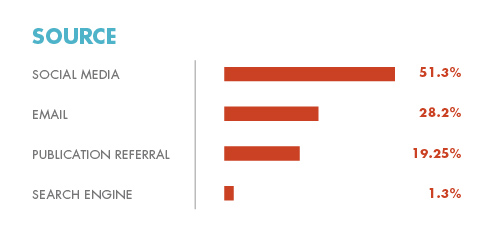
Keep a Print Component
Digital continues to encroach upon print, but nothing replaces holding a nice print piece in your hand. Clients received a custom deck of aviation trivia cards that teased them to go online and play the game. Still, the game functions independently of the cards so anyone can play.
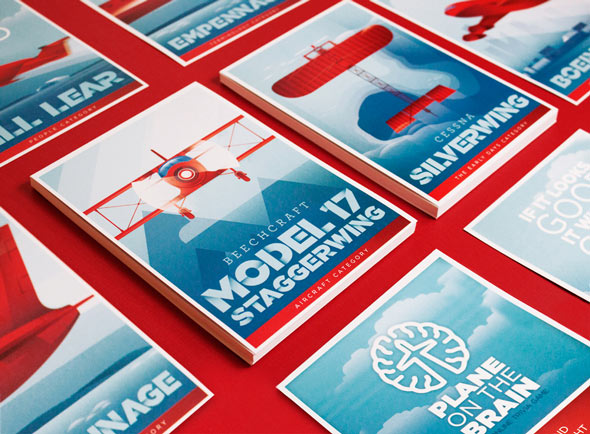
Remove Barriers
We knocked down barriers of cost and time by making the game free and fast to play. Of course, it also had to be fun, easy to share with friends – and allow boasting rights by being able to post your score.
Make ’em Laugh
We sprinkled in a bit of snark to keep things interesting. Here are a few examples (with the correct answer bolded).
As Beechcraft CEO, Olive Ann Beech hung small flags outside her office to signify:
A. Her current mood.
B. That she wanted a cup of tea.
C. Whether to speed up or slow down production.
D. Areas of greatest sales.
What was one of the nicknames for the Learjet 23?
A. The Lear Special.
B. The Pocket Rocket.
C. Moya’s Miracle.
D. The Little Plane That Could.
Why did Clyde Cessna start his own company?
A. His domineering father said he’d never amount to anything.
B. He and Walter Beech disagreed about the best type of wing.
C. He wanted to take the “can’t” out of “cantilever.”
D. The City of Wichita offered him a financial incentive.
What are pants?
A. Removable storm covers used to protect an aircraft’s landing gear on the ground.
B. Another name for engine nacelles.
C. Fairings that cover the airplane’s landing wheels.
D. Those things that even legendary pilots put on one leg at a time.
Encourage Conversation
People tend to favor quizzes, especially shareable or competitive quizzes. They prompt questions like, “How well did you do?” and “Can you beat my score?” Good-natured boasting and one-upmanship generate laughs – and drive up your numbers.
Know Your Audience
As a niche product, Plane on the Brain speaks to a distinct subset of the population. It didn’t try to be all things to all people. More than 15 media outlets and aviation organizations shared the game, which was then re-shared by their readership and members. Our largest traffic spike came as readers’ posts aggregated and compounded on Facebook.
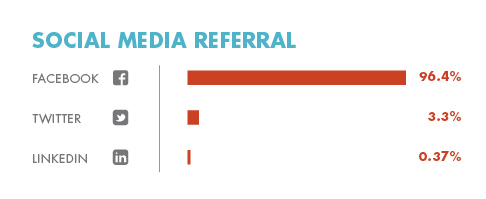
Troubleshoot and Test
Creating a website-based game requires tenacity. Challenges abound. Usability testing becomes critical. Players will drop out of a game entirely if it’s not clear to them how to play, or if it doesn’t function as they might expect on desktop, tablet and smartphone. We had to test over and over. And over. Making adjustments. Smoothing the process. Ensuring it worked for game-minded folks and those who aren’t.
Our target market represents a wide range of ages, gaming knowledge and technology. Using unnecessarily bleeding-edge modern code can have a negative impact on people using older technology to play the game. We built the site with modern code and languages, but also kept older browsers in mind. The Internet can be accessed by devices and software grossly underpowered and incapable of handling in-browser motion and layouts. But we can’t write off that subset of people without at least considering what we can do to improve the playability of the game on suboptimal hardware and software.
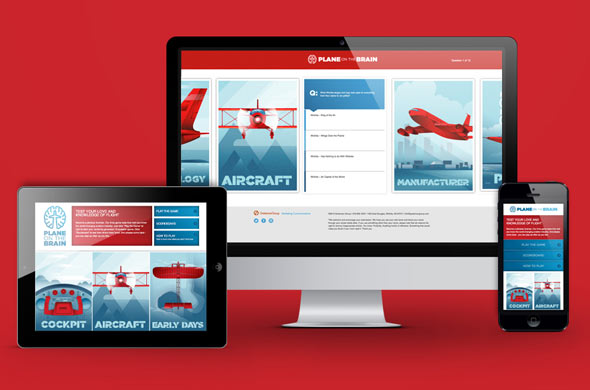
Ensure a Good Experience for Your Customers
We went round and round about this one, frankly. But we ultimately decided that the game had to work okay in Internet Explorer 7 (IE7) just as, in the words of one developer, in “real browsers.” We had to think through all the cool functionality we hoped to use – interesting transitions, movement, fading, opacity and more. We didn’t want to eliminate those elements, so we duplicated the site for IE7 users. Even though these users only make up a 1.34% worldwide market share, they include some friends we didn’t want to leave out.
Serve a Greater Good
Give when you can. As part of the campaign, we made a donation to the nonprofit Kansas Aviation Museum, which serves us such an ongoing resource to us – and all who want to learn more about flight’s living legacy. If we’re to inspire the next generation to love aviation as we do, to support it, to consider it as a career – we have to give to get. KAM Executive Director Lon Smith agrees, saying, “It is critical that we continue to encourage the preservation of our unique and rich aviation heritage.” The museum helped in our outreach, too, essentially partnering with us in its promotion. Issuing a release to media connections. Sharing with members and stakeholders. Talking up the game with volunteers and visitors.
